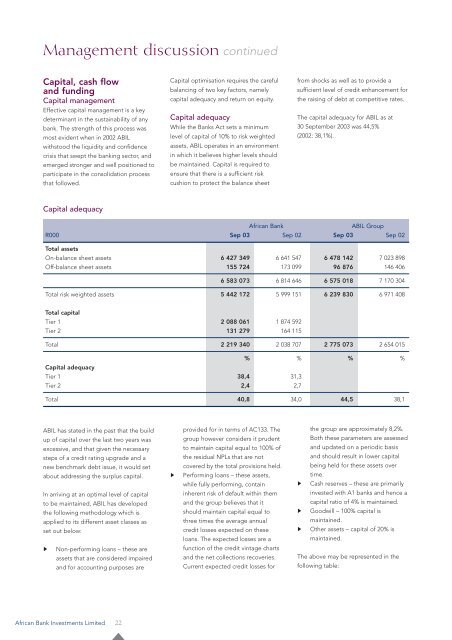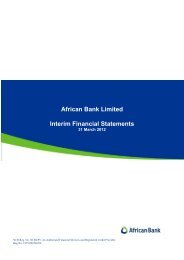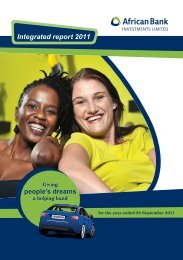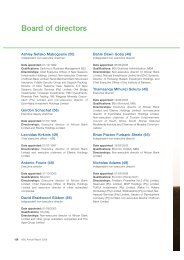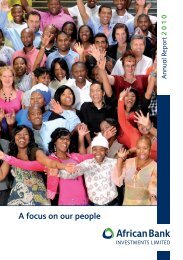Download - African Bank
Download - African Bank
Download - African Bank
You also want an ePaper? Increase the reach of your titles
YUMPU automatically turns print PDFs into web optimized ePapers that Google loves.
Management discussion continued<br />
Capital, cash flow<br />
and funding<br />
Capital management<br />
Effective capital management is a key<br />
determinant in the sustainability of any<br />
bank. The strength of this process was<br />
most evident when in 2002 ABIL<br />
withstood the liquidity and confidence<br />
crisis that swept the banking sector, and<br />
emerged stronger and well positioned to<br />
participate in the consolidation process<br />
that followed.<br />
Capital adequacy<br />
ABIL has stated in the past that the build<br />
up of capital over the last two years was<br />
excessive, and that given the necessary<br />
steps of a credit rating upgrade and a<br />
new benchmark debt issue, it would set<br />
about addressing the surplus capital.<br />
In arriving at an optimal level of capital<br />
to be maintained, ABIL has developed<br />
the following methodology which is<br />
applied to its different asset classes as<br />
set out below:<br />
Non-performing loans – these are<br />
assets that are considered impaired<br />
and for accounting purposes are<br />
<strong>African</strong> <strong>Bank</strong> Investments Limited 22<br />
Capital optimisation requires the careful<br />
balancing of two key factors, namely<br />
capital adequacy and return on equity.<br />
Capital adequacy<br />
While the <strong>Bank</strong>s Act sets a minimum<br />
level of capital of 10% to risk weighted<br />
assets, ABIL operates in an environment<br />
in which it believes higher levels should<br />
be maintained. Capital is required to<br />
ensure that there is a sufficient risk<br />
cushion to protect the balance sheet<br />
provided for in terms of AC133. The<br />
group however considers it prudent<br />
to maintain capital equal to 100% of<br />
the residual NPLs that are not<br />
covered by the total provisions held.<br />
Performing loans – these assets,<br />
while fully performing, contain<br />
inherent risk of default within them<br />
and the group believes that it<br />
should maintain capital equal to<br />
three times the average annual<br />
credit losses expected on these<br />
loans. The expected losses are a<br />
function of the credit vintage charts<br />
and the net collections recoveries.<br />
Current expected credit losses for<br />
from shocks as well as to provide a<br />
sufficient level of credit enhancement for<br />
the raising of debt at competitive rates.<br />
The capital adequacy for ABIL as at<br />
30 September 2003 was 44,5%<br />
(2002: 38,1%).<br />
<strong>African</strong> <strong>Bank</strong> ABIL Group<br />
R000 Sep 03 Sep 02 Sep 03 Sep 02<br />
Total assets<br />
On-balance sheet assets 6 427 349 6 641 547 6 478 142 7 023 898<br />
Off-balance sheet assets 155 724 173 099 96 876 146 406<br />
6 583 073 6 814 646 6 575 018 7 170 304<br />
Total risk weighted assets 5 442 172 5 999 151 6 239 830 6 971 408<br />
Total capital<br />
Tier 1 2 088 061 1 874 592<br />
Tier 2 131 279 164 115<br />
Total 2 219 340 2 038 707 2 775 073 2 654 015<br />
% % % %<br />
Capital adequacy<br />
Tier 1 38,4 31,3<br />
Tier 2 2,4 2,7<br />
Total 40,8 34,0 44,5 38,1<br />
the group are approximately 8,2%.<br />
Both these parameters are assessed<br />
and updated on a periodic basis<br />
and should result in lower capital<br />
being held for these assets over<br />
time.<br />
Cash reserves – these are primarily<br />
invested with A1 banks and hence a<br />
capital ratio of 4% is maintained.<br />
Goodwill – 100% capital is<br />
maintained.<br />
Other assets – capital of 20% is<br />
maintained.<br />
The above may be represented in the<br />
following table:


